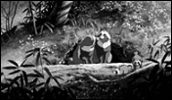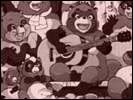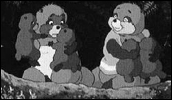Pompoko
- Year
- 1994
- Original title
- Heisei Tanuki Gassen Ponpoko
- Japanese title
- 平成狸合戦ぽんぽこ
- Director
- Cast
- Running time
- 119 minutes
- Published
- 28 March 2002



by Tom Mes
With the international attention and praise heaped upon Hayao Miyazaki in recent years, one would almost forget that there is another genius at work in the offices of Studio Ghibli. Quite unjustly overshadowed by the success of his fellow Ghibli founder, Isao Takahata is not only the more experienced director of the two (having started his directorial career in 1968 with Little Norse Prince Valiant / Taiyo no Ouji Horusu no Daiboken), his work is also more varied. To put it somewhat disrespectfully: Takahata's films aren't always about heroic twelve-year-old girls.
It's certainly not my intention to slam Miyazaki with this remark - the man deserves all the praise that has come his way - but in my view Takahata is the more interesting director. Unlike Miyazaki, who is an illustrator/animator first and foremost, Takahata is a consummate director: during the process of filmmaking he never once puts brush to paper. As a result, the look of a Takahata film changes from title to title, and is related to each film's subject and themes, rather than its director's signature style. In the case of Pompoko, the style even changes during the film. Depending on the roles its raccoon characters adopt toward their environment and toward each other, the little creatures are drawn in a very realistic, a more anthropomorphic, or in a more simple cartoon-like manner (the latter allegedly inspired by the work of manga artist Shigeru Sumiura).
Although their changing styles and subjects would suggest otherwise to the casual viewer, Takahata's films are closely interconnected and share a single point of view. With their settings in various time periods (the war years in Grave of the Fireflies / Hotaru no Haka, and Osaka of the 1970s in Chie the Brat / Jarinko Chie for instance), all his films are history lessons in a way, or rather portraits of human behaviour at specific periods in time. The word 'Heisei' in the Japanese title of Pompoko reflects this (referring to the period that started with emperor Aikihito's ascension to the throne in 1989) and while its protagonists are raccoons, the intent is to show human behaviour through their eyes, offering a different perspective on the consequences of human actions.
In Pompoko those human actions consist of the expansion of cities into the surrounding countryside. Bulldozers invade the foothills of the Tama mountains, west of Tokyo, where a tribe of raccoons has been living a life of luxury. Faced with the destruction of their natural habitat, they decide to fight back, utilising the skills of disguise for which they are known traditionally and mythically. However, over the course of several peaceful decades, most raccoons have forgotten these skills and it takes a strict regiment of practice, overseen by grande dame Orokubaba, to put the tanuki back in touch with their roots. The first attempts are moderately successful, as the raccoons transform themselves into faceless humans to scare off unwelcome visitors. Soon the more militant members of the clan start taking more drastic measures, transforming themselves into boulders to knock trucks and bulldozers off the road. This results in a number of human casualties, but not the end of construction.
Pompoko delivers a serious message, but does so with a good deal of humour and positivity (enhanced by the wonderful folklorist music of the group Shang Shang Taifu). That Takahata doesn't try to tug at the heartstrings with an overdose of Watership Down-esque sentimentality is much to the film's benefit. The furry heroes are not treated as cuddly potential roadkill, but as determined, stubborn, good-natured rascals with individual character traits. Their humorous and often spectacular metamorphoses into everything from stone statues to near-perfect humans (save the brown rings around the eyes) are a delight to watch and one of the film's main draws. Similarly, the humans are not portrayed as mindless thugs bent only on destruction, which gives the film a lot of balance and perspective. The final moments sum this up succinctly: without wishing to give anything away, there is one characteristic scene in which a young family that inhabits one of the new houses in what was once the animals' domain are delighted when they spot a group of raccoons scurrying around the garden.
Although the overall sense one gets for most of the film's running time is of a somewhat reactionary longing for the indistinct 'good old days' when man and nature lived in more harmonious circumstances, this too is offset by a good dose of relativity in the final moments of the film, which paints a not altogether negative image of a compromise between worlds old and new. Even the tanuki themselves, though their clan-like structure and solidarity seem like glorified examples of the kind of close-knit bonds that modern humans have lost, are seen in the beginning of the film as an in-fighting bunch leading far too luxurious a life. It's not until they are faced with the threat of a common enemy that they band together to form a tight unit. Harmony is never an absolute state, Takahata seems to say, and one must change with the times and with the situation in order to make the best out of life.
Pompoko is a delightful, often uproariously funny film, at once childishly irreverent and thoughtfully mature. Being a Ghibli work, it is beautifully rendered and technically impeccable, with a great number of memorable set pieces. Let's hope that the ever-increasing foreign interest in the Ghibli catalogue will also benefit this great film.